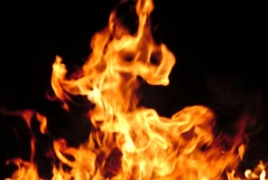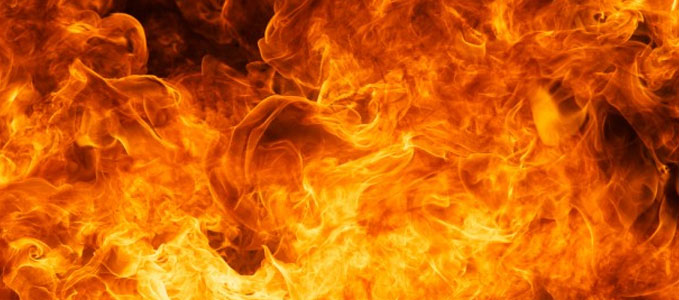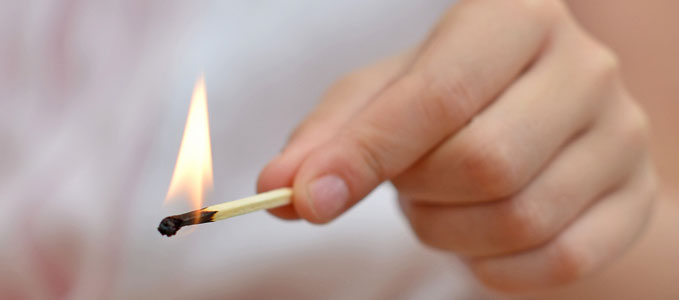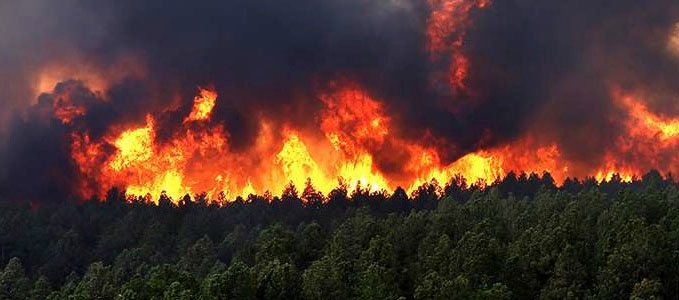
Scientifically, fire is "a rapid, persistent chemical reaction that releases heat and light, especially the exothermic combination of a combustible substance with oxygen." This chemical reaction is called oxidation, which happens when oxygen atoms in the atmosphere combine with atoms "borrowed" from other elements, in this case, from fuel that be anything from a solid (wood, plastic, or wax), to a liquid (gasoline or alcohol), or a gas (propane). For oxidation to take place, the fuel must be heated to a certain temperature, known as the ignition temperature. When a fuel reaches its ignition temperature, a chemical reaction occurs that begins to decompose it into flammable gases known as volatiles.

The ancient Greeks considered fire one of the major elements in the universe, alongside water, earth and air.
According to the U.S. National Fire Protection Association, cooking equipment is the leading cause of home structure fires and home fire injuries. Smoking is the leading cause of civilian home fire deaths. Heating equipment is the second most common cause of home fire fatalities.
Fires behave differently. Some burn slowly and evenly; others are extremely hot, burning fiercely and quickly. Different fires have different colored flames. Some fires start easily; others don’t. Some fires produce deadly gases that could kill you if not ventilated. The behavior of the fire often depends on the fuel. Other factors or variables may include where the fuel is situated and how near it is to other fuels, the weather (especially wind and relative humidity), oxygen concentration and, in the case of outside fires, the shape of the terrain.
In a fire every second counts, so you (and the children in your care) must always be prepared. Escape plans are designed to get you out of the building quickly. Some tips to consider when preparing this plan include:
-Find two ways to get out of each room.
-If the primary way is blocked by fire or smoke, you will need a second way out. A secondary route might be a window onto a neighboring roof or a collapsible ladder for escape from upper story windows.
-Make sure that windows are not stuck, screens can be taken out quickly, and that security bars can be properly opened.
-Practice feeling your way out of the building in the dark or with your eyes closed.

Children playing with fire cause hundreds of deaths and injuries each year.
During a fire
-Crawl low under any smoke to your exit - heavy smoke and poisonous gases collect first along the ceiling.
-When the smoke alarm sounds, get moving. Get out fast. You may only have seconds to escape safely.
-If there is smoke blocking your door or first way out, use your second way out.
-Smoke is toxic. If you must escape through smoke, get low and go under the smoke to your way out.
-Before opening a door, feel the doorknob and door. If either is hot, leave the door closed and use your second way out.
-If there is smoke coming around the door, leave the door closed and use your second way out.
-If you open a door, open it slowly. Be ready to shut it quickly if heavy smoke or fire is present.

Although technology development, expansive fire departments and water access have greatly reduced the amount of massively devastating fires, hey still happen. Here are some of the worst fires in modern history:
Station Nightclub Fire, West Warwick, Rhode Island, U.S. February 20, 2003
When performing at Station nightclub, hard rock band Great White used pyrotechnic sparks for visual effect. As they started their set, a flash fire began when the stage props were set ablaze. Fire alarms were sounded and a crowd of over 400 people all rushed towards the front exit. People were panicking and a crush formed in the small and narrow hallway leading to the exit. This completely blocked the passage. The entire club was engulfed and burned to the ground in six minutes. 100 people were killed by the fire, 230 were injured, and only 132 made it out unharmed.
Windsor Tower Fire, Madrid, Spain. February 12, 2005
The Windsor Tower was built in 1979 in the financial center of Madrid, Spain. The office building was 106m high and had 32 floors, which made it the 8th tallest building in Madrid. Around midnight, a fire was detected on the 21st floor of the building. It quickly spread to every floor in the building above the 2nd. It took firefighters around 24 hours to distinguish the blaze. There was extensive slab damage to the structure and the building was totally destroyed by the fire. It was not equipped with sprinklers. Seven firefighters were injured and nobody was killed in the blaze. The estimated cost of the damage was €22 million. The Windsor tower fire is considered one of the worst in the long history of Madrid.
Cocoanut Grove Fire, Boston, Massachusetts, U.S. November 28, 1942
The Cocoanut Grove was a nightclub in Boston, Massachusetts. On that evening, the club was filled with around 1,000 people, which was well above the buildings official capacity of 460. The structure was decorated in a Casablanca tropical style. The restaurant, bars, and lounges inside contained flammable paper palm trees, cloth draperies covering the ceiling, flammable furniture, and other flimsy decorations, some of which obscured exit signs. The blaze quickly spread and a fire ball burst across the central dance floor. The entire club was on fire in five minutes. Many patrons attempted to exit through the main door, which was a single revolving door and quickly became useless as a human crush formed. The Cocoanut Grove fire remains the deadliest nightclub fire in U.S. history, as 492 people were killed and hundreds more were injured.
Niterói Circus Fire, Niterói, Brazil. December 15, 1961
Niterói is a municipality in the state of Rio de Janeiro, southeast region of Brazil. The state was founded on November 22, 1573 by the Tupi Amerindian chief Araribóia. On December 15, 1961, the Gran Circus Norte-Americano was performing in Niterói. The circus was a popular show and routinely sold out. The organizers would set up multiple huge tents for each act. On this evening, one of the tents caught fire. Within minutes the entire tent was consumed by the flames and 323 people were killed by the blaze. It is one of the worst tragedies in Brazilian and circus show history.
The World Trade Center Fires, New York, U.S. September 11, 2001
Some of the most infamous fires in history are the ones that brought down the World Trade Centers on September 11, 2001. When two hijacked aircrafts crashed into the World Trade Centers, fire consumed numerous floors of the buildings. The Twin Towers completely collapsed 56 and 103 minutes after the plane impact. In all 2,974 people died in the attacks. Studies by the U.S. Government concluded that the heat from the fires melted the infrastructure and caused numerous floors to pancake and collapse upon each other.

